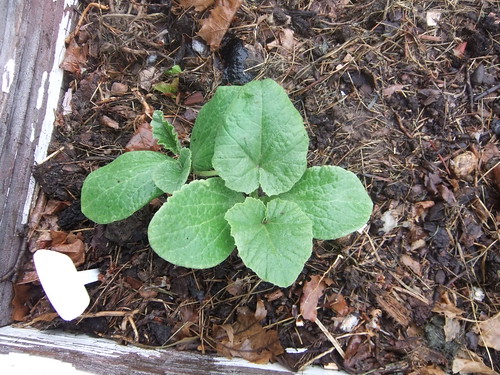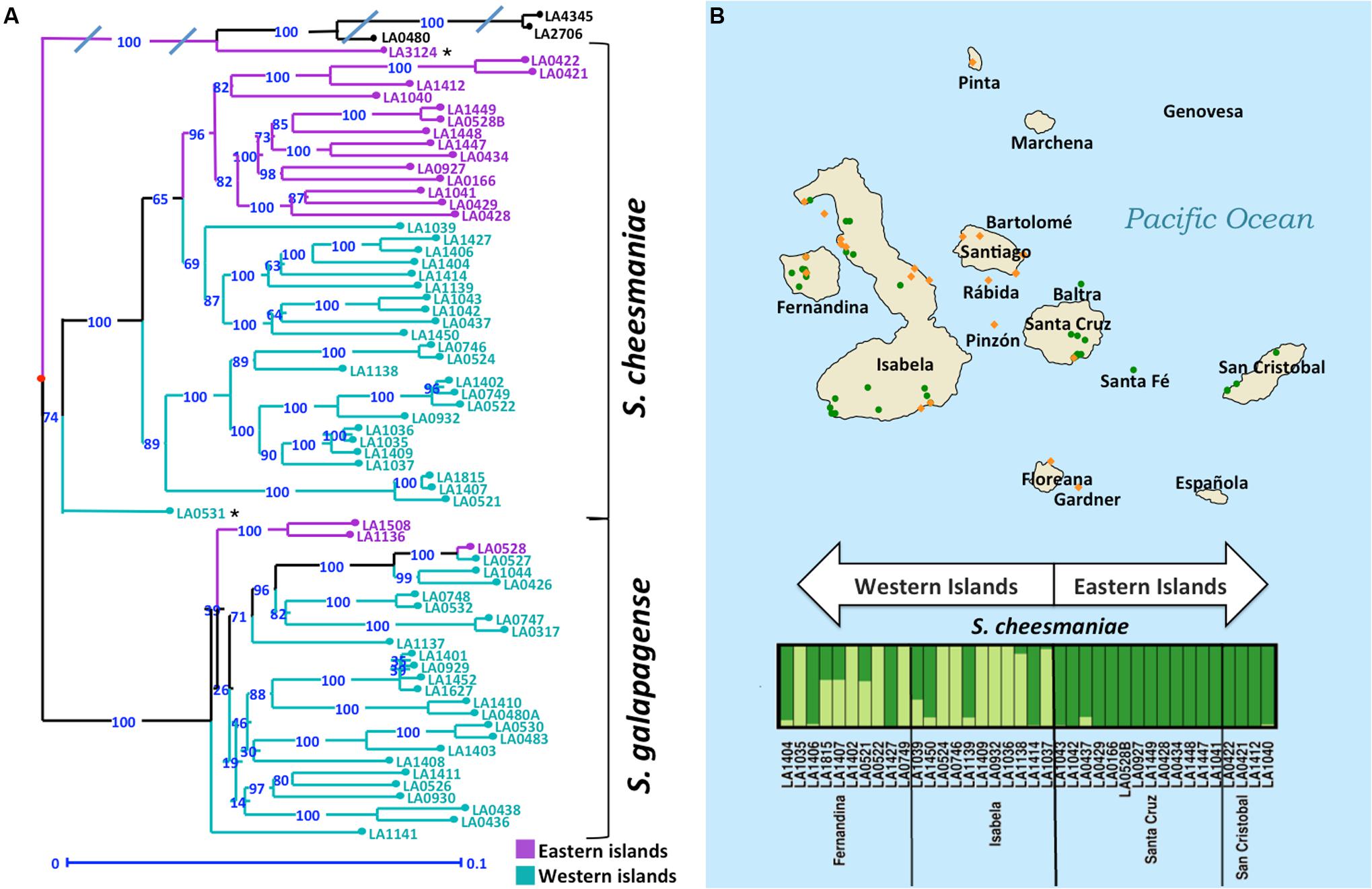|
|
Post by meizzwang on May 17, 2018 17:34:07 GMT -5
Variety: Tomato, Galapagos Wild (not to be confused with Galapagos Wild Tomato) I've seen these similar seeds marketed as Solanum cheesmaniae, but it appears to be a hybrid. Seeds are way too big to be a pure cheesmaniae. Location: Northern California, Zone 9B Source: Terrior Seeds GROW REPORT:
Seed germination: very easy to germinate, no problems. Vigor:crazy vigorous throughout the entire grow cycle Production: heavy, almost too much! Early, middle, or late season producer? mid season. Indeterminate, so it keeps on producing even through the beginning of winter. When I took the plant down (December, day temps: ~50F and night temps, mid to low 30's), it was still growing strong! Possibly good candidate to study for cold tolerance. Disease Resistance:Excellent! Got grey mold and shook it off! I didn't get any other disease, so not sure how resistant it is to say early blight, late blight, Septora, etc. Soil: grown in very poor quality gravel-based soil that was highly amended with organic matter. Despite the crappy soil, this plant did exceeding well and grew rapidly. Water: standard Deep watered once a week after planting into the ground, and then cut back to once every 2 weeks until fruit starten ripening. By end of September, the plants received no irrigation. Challenges: Flavor isn't great unless it's warm/sunny while the fruits are ripening. Tomatoes split upon harvesting, even if plants aren't over-watered: the slightest amount of pressure causes them to crack. Fruits are pretty small, maybe the size of a small marble. Needs to be eaten right away or kept on the vine because the shelf life isn't that great due to splitting Easy or Difficult to Grow? Very easy. Some ripening fruit, these are maybe 2 weeks away from peak maturity. The tomatoes that almost began forming an orange tinge (not shown) and had sepals turn yellow (nutrient/environmental stressed) tasted the best. If you harvest at the stage pictured below, it can be a bit sour, especially if the weather hasn't been warm weeks prior to harvesting: 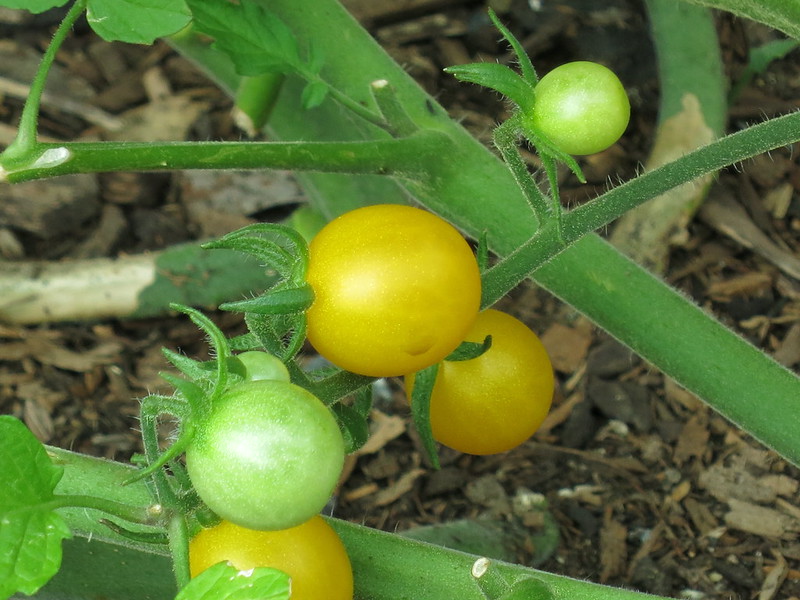 TASTE REPORT: TASTE REPORT:
Appearance: standard cherry tomato size. Beautiful yellow fruits that come in clusters of ~10-20. As they reach peak ripeness, the overall color turns slightly orange, but not quite. If you let them all ripen on the vine, Clusters can be harvested all at once, making picking easy and efficient. Incredible fruit bowl appeal, almost had a decorative effect, especially when harvested in clusters! Ripeness: Peak ripeness seems to be maybe 1-2 weeks after the fruit have turned yellow, weather dependent. They hold on vine well and improve in flavor the longer they're on, so long as the weather is warm. They won't fall off the plant: they'll shrivel up and rot before that happens! As mentioned earlier, If you wait long enough, you can harvest entire trusses at a time, but be very careful because they split with the slightest amount of pressure. Early in the harvest season (late July), the samples I tried had a really funky, secondary compound flavor to it, but in late September thru December, that flavor disappeared. Just don't pick these too early, and let them ripen on the vine all the way through. Texture: Soft and slightly juicy. Very thin skin. Sweetness: Sugar content was decent at optimal ripeness, but not candy sweet like sungold. Acidity: This variety had great acidity to balance the sweetness, but when it wasn't warm and fruits were past peak ripeness, they tasted off. You really need the sweetness with this variety to balance the acid, and that sweetness seems highly environmentally induced. Rating: 6/10 Despite the relatively low rating, I wouldn't write this one off as not worth growing. This plant showed extreme phenotypic variation in terms of flavor, so I think if you have the right environment (ie. warm, sunny conditions throughout the grow season), you can get consistently tasty fruit....in fact, if you live in a warm climate, I highly recommend giving it a shot to see what you think! The flavor is a bit exotic, much different from your every day tomato, and no regrets growing this variety! We had fresh, tasty tomatoes in November because of the Galapagos Island Tomato! Got completely full of disease and then shook it off! The plants continued to grow profusely even in cooler weather. Thing is, my wife was crazy about the flavor, but I only liked a few of the samples I tried. Later season fruit definitely had better flavor in my opinion.
|
|
|
|
Post by steev on May 17, 2018 18:59:27 GMT -5
Great review, so thorough and informative; sounds like it would do well for me.
|
|
|
|
Post by keen101 (Biolumo / Andrew B.) on May 17, 2018 22:57:54 GMT -5
Variety: Galapagos Island Tomato (not to be confused with Galapagos Wild Tomato) They call it Solanum cheesmaniae, but it appears to be a hybrid. Seeds are way too big to be a pure cheesmaniae. Excellent review! nearly identical though more in depth to my review of the exact same one from Terroir Seeds / Underwood Gardens. It is a VERY vigorous grower and may indeed contain SOME cheesmaniae ancestry, but it does not appear to be pure S. cheesmaniae as the fruits are slightly larger, but still in the large marble / small cherry tomato size. Leaf structure is also different from cheesmaniae, having both traits of cheesmaniae and domestic tomato leaves. Though i am told there is much genetic variation within different accessions of S. cheesmaniae so i have not confirmed differences in S. cheesmaniae leaf structure in pure accessions. store.underwoodgardens.com/Wild-Galapagos-Tomato-Solanum-cheesmaniae/productinfo/V1182/I still think it is very worth growing as it has high vigor and high production. However i have tried to publish my review several times on the Terrior seeds / underwood gardens website and they quietly refused to publish my positive reviews as it seems they do not want anyone to know they are not pure S. cheesmaniae and/or believe that they truly are pure S. cheesmaniae. Whatever, those of us working with wild galapagos tomatoes know the truth. Still worth growing and/or using in a breeding project and or wild tomato population. And indeed i am growing it again this year. |
|
|
|
Post by meizzwang on May 21, 2018 15:41:31 GMT -5
Thanks for the feedback! Okay, made a quick correction: I checked the packets the other night and the seeds came from Terrior Seeds! Well, In case anyone has any doubt about these Galapagos Island tomato seeds, here's a comparison of the real deal Solanum cheesmaniae from TGRC (to the right) compared to the hybrid seeds offered by various seed companies (left, center). Maybe these are crossed with pimps, anyone know? 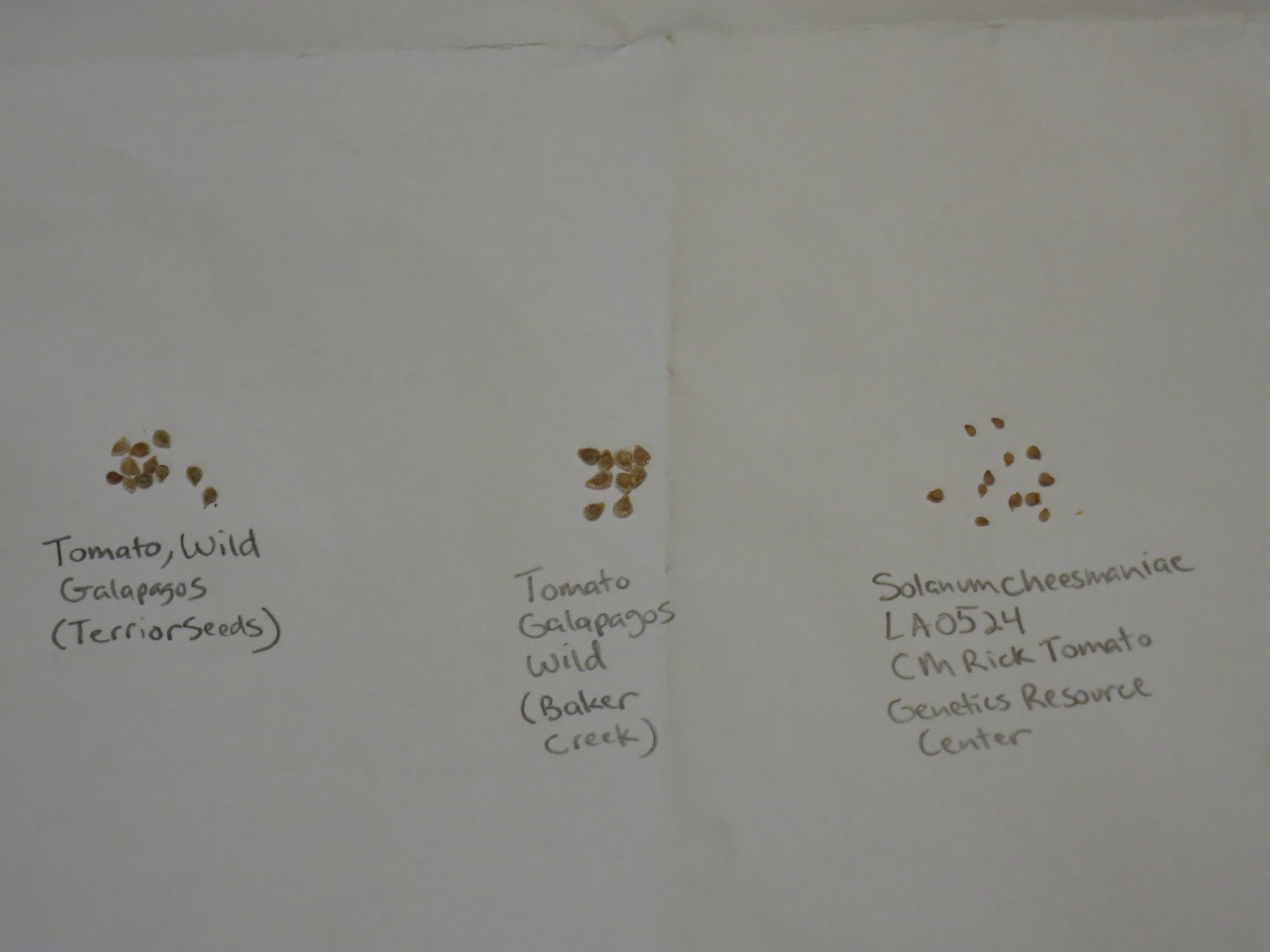 And just for fun, here's Solanum cheesmaniae LA0529. I'll do an in depth report on these real cheesmaniae variants once they start producing. For sure, this batch was a PITA to germinate, I think I got 1/10 to germinate, and they take about 2 weeks from planting to sprout: 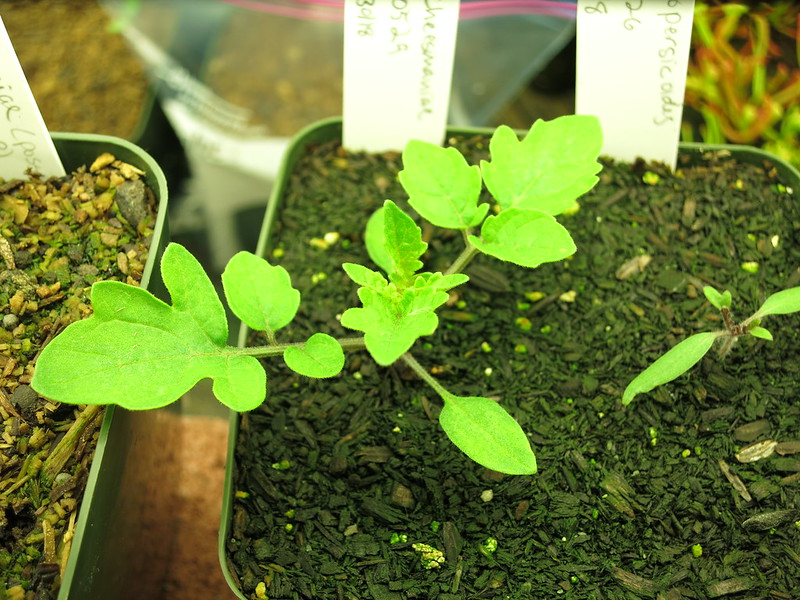 |
|
|
|
Post by keen101 (Biolumo / Andrew B.) on May 22, 2018 9:07:37 GMT -5
Here is my current pure cheesmaniae from seed saved from tgrc stock grown last year. Accession number has been lost. But it has been reported that leaf shape/ structure is variable for cheesmaniae from island to island, but i do not know. I also know there is at least one accession that is suspected to be a pimp hybrid and at least one that is suspected to be a galapagense hybrid (LA0530?). I can't remember which without going back and rereading the paper on the genetic study. At least mine has the atv purple stem gene so that is consistent (i don't think most galapagense have that gene?). But yes i was surprised last year that all of my cheesmanaie resembled pimps foliage and vining habit very closely, but they were not pimps. flic.kr/p/26jiUDq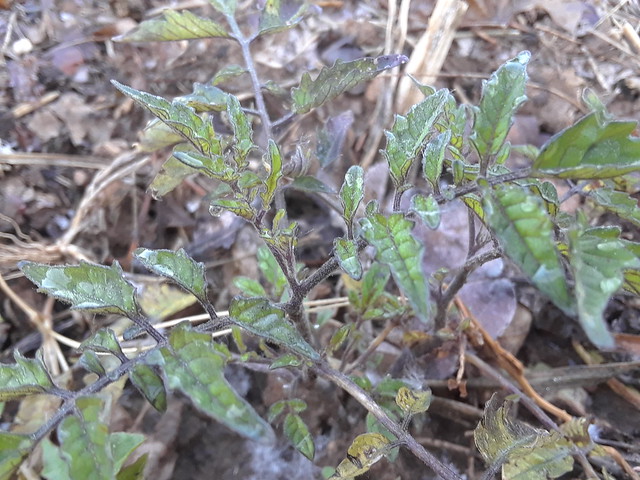 Solanum cheesmaniae Solanum cheesmaniae by Andrew Barney, on Flickr Possible accessions this one could be are: LA0422 LA0428 LA0429 LA0434 LA0437 LA1414 LA1427 LA3124 Last year i only got one galapagense plant/accession to set viable fruit and only one, maybe two for S. cheesmaniae. And of those i don't think the fruits were even fully ripe. Either way, seed grown from both saved seed grew MUCH easier than tgrc seed. Joseph also had better germination easiness from saved seed. |
|
|
|
Post by keen101 (Biolumo / Andrew B.) on May 22, 2018 9:15:01 GMT -5
I've looked at that key before, its slightly useful but not really. Practically useless from my perspective. I did not see any mention of hairiness on that key for cheesmaniae at all. Unless You meant "densely pubescent" for S. Cheesmanii f. minor which is actually S. Galapagense which have the type 4 trichomes that are whitefly resistant. Very hairy. |
|
|
|
Post by keen101 (Biolumo / Andrew B.) on May 22, 2018 9:23:23 GMT -5
No. But from what i observed last year, fruit size is very small marble size a little bigger than pimp/current tomatoes, yellow and smooth fruit. No hairiness. |
|
|
|
Post by meizzwang on May 22, 2018 17:33:19 GMT -5
FWIW, in reference to the "S. cheesmaniae" (LA0529) plant picture I posted, in the accession description, it's noted that "Collection Notes: SAL257. 9/11/57. Fernandina Crater. Probably pimp. type. See attached description. 78 seeds. No herbarium material collected. [Note added later:] Glabrous, mingling with hairy type. Bowman notes: Tomato seeds from Narborough Island; fruits orange-green in color; leaves and stems glabrous. Plants growing beside, with leaves in contact with tomato plants with hairy stems and leaves (seeds of which in separate packet) Sept. 11, 1957. "
I suspect by the time many of these wild accessions were collected, they had already hybridized with pimps, but I'm sure there's "pure pimps" out there. After reading other Solanum cheesmanaie accessions I acquired at random from TGRC, a few others mentioned that they might be pimps or pimp hybrids.
|
|
|
|
Post by keen101 (Biolumo / Andrew B.) on May 22, 2018 18:58:43 GMT -5
FWIW, in reference to the "S. cheesmaniae" (LA0529) plant picture I posted, in the accession description, it's noted that "Collection Notes: SAL257. 9/11/57. Fernandina Crater. Probably pimp. type. See attached description. 78 seeds. No herbarium material collected. [Note added later:] Glabrous, mingling with hairy type. Bowman notes: Tomato seeds from Narborough Island; fruits orange-green in color; leaves and stems glabrous. Plants growing beside, with leaves in contact with tomato plants with hairy stems and leaves (seeds of which in separate packet) Sept. 11, 1957. " I suspect by the time many of these wild accessions were collected, they had already hybridized with pimps, but I'm sure there's "pure pimps" out there. After reading other Solanum cheesmanaie accessions I acquired at random from TGRC, a few others mentioned that they might be pimps or pimp hybrids. Cool! That is very interesting. I look forward to your full grow report and future pictures on that line. tgrc.ucdavis.edu/Data/Acc/Wildspecies.aspx biolumo.com/index.php?title=Tomato_Breeding_Database biolumo.com/index.php?title=Tomato_Breeding_DatabaseOh, yes, there are pimps that have made it to the galapagos islands. Whether they were there before or not is anyones guess. it makes for some interesting questions about evolution of where the galapagos island species originated. But here is the nice google maps from TGRC that shows where they are. Interesting to track down the known hybrids and see what is growing next to them in close proximity. Let me track down the paper that talked about the DNA of most of these accessions and their findings. I think it will add a LOT to this discussion... Will be back soon (hopefully) with that research paper link... So zooming in on Island Fernandina it does not look like there are any pimps recorded on that island. But it is growing in VERY close proximity to LA0530 which is galapagense. So it could be a cheesmaniae-galapagense hybrid... IDK. The early leaf structure looks like galapagense to me a bit, but it's still early.. |
|
|
|
Post by keen101 (Biolumo / Andrew B.) on May 22, 2018 19:18:36 GMT -5
still looking for that paper... but in the meantime i found this: link.springer.com/article/10.1186/1471-2148-13-175Differences in insect resistance between tomato species endemic to the Galapagos Islands LA0529 is an outlier having way more whitefly resistance than the other cheesmaniae, therfore supporting the idea that LA0529 in a galapagense hybrid... Take a look at the table for whitefly resistance and this line too: EDIT: maybe this paper was the one i was looking for:  IT looks to me that LA0529 overlaps with both cheesmaniae and galapagense. |
|
|
|
Post by keen101 (Biolumo / Andrew B.) on May 22, 2018 19:28:51 GMT -5
|
|
|
|
Post by keen101 (Biolumo / Andrew B.) on May 22, 2018 19:44:52 GMT -5
FWIW, in reference to the "S. cheesmaniae" (LA0529) plant picture I posted, in the accession description, it's noted that "Collection Notes: SAL257. 9/11/57. Fernandina Crater. Probably pimp. type. See attached description. 78 seeds. No herbarium material collected. [Note added later:] Glabrous, mingling with hairy type. Bowman notes: Tomato seeds from Narborough Island; fruits orange-green in color; leaves and stems glabrous. Plants growing beside, with leaves in contact with tomato plants with hairy stems and leaves (seeds of which in separate packet) Sept. 11, 1957. " I suspect by the time many of these wild accessions were collected, they had already hybridized with pimps, but I'm sure there's "pure pimps" out there. After reading other Solanum cheesmanaie accessions I acquired at random from TGRC, a few others mentioned that they might be pimps or pimp hybrids. So, coming back to this. You have to realize that back in 1957 when those notes were written they still thought cheesmaniae and galapagense were the same species. And so "pimp type" probably referred to the smooth fruited type. They might have suspected pimp crossing way back then. But again this comes back to the evolution of these tomatoes. Did S. cheesmaniae descend and evolve out of S. pimpinellifolium? Maybe. I have no idea. All i know is the S. cheemaniae seems to have VERY similar foliage to S. pimpinellifolium and similar, though slightly larger and yellow smooth fruit. |
|
|
|
Post by meizzwang on May 23, 2018 15:52:38 GMT -5
It seems, like in many other plant species that share the same habitat and can interbreed, that historic hybridization, followed by back crossing and inbreeding can result in phenotypes that look like a "pure" species but in fact are a genetic mixture of various species. As an example, Let's hypothetically say S. habrochaites was interbred with S. lycopersicum for resistance to late blight: if you look at the resulting hybrid, if it was back-crossed to S. lycopersicum enough, it's difficult to find any visual, physical characteristics of S. habrochaites.
Of course, you also have random chance mutations that occur far less often than hybridization, but single mutations can be the difference between one species and another.
|
|
|
|
Post by keen101 (Biolumo / Andrew B.) on May 24, 2018 0:02:08 GMT -5
Haha yes. Is not that small yellow cherry tomato everyone loves recently bred from a wild tomato? Sun Gold. Couldn't think of it at first lol.
I think that is why LA1996 grew so well for me last year. Really its mostly just a domestic red determinate tomato with just a hint of blue bred from S. Chilense. But i suspect some other s. Chilense traits may still be kicking around which contribute to it's hardiness and or drought tolerant genes for it to thrive in my conditions.
|
|
|
|
Post by meizzwang on May 30, 2018 16:19:34 GMT -5
Slightly off topic, but here's a preliminary germination/grow report of various tomato species, including a few from the Galapagos Islands. 1) Solanum cheesmaniae LA0529, growing pretty fast and is quite happy. only one seed sprouted, so I did the whole bleach treatment and tried sowing more. Will see if that works: 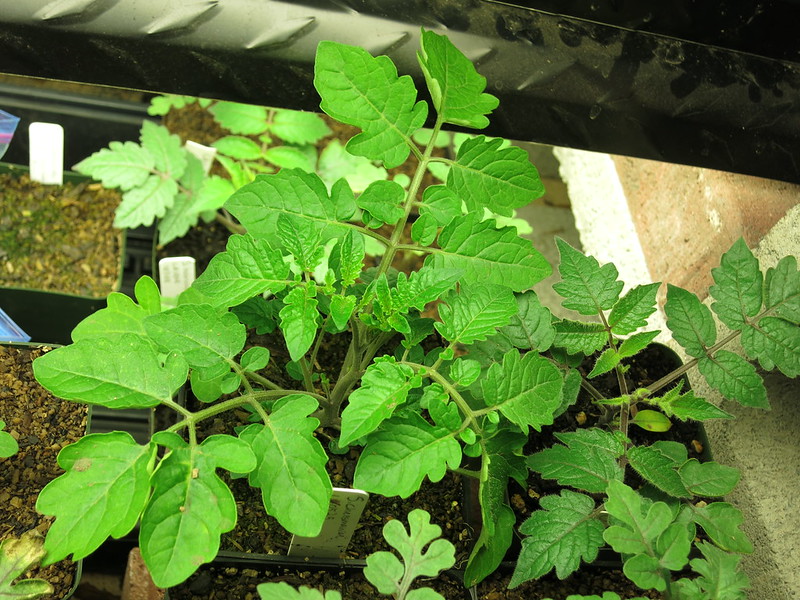 2) Another accession of Solanum cheesmaniae, LA0531. Germination was also very poor despite bleach treatment, but I got 2 to sprout (12 days after sowing). They're just starting to gain momentum, they seem to like this warm weather we had recently:  3) Solanum galapagense LA1044. No treatment, and 5/5 germinated. These really need warmth to sprout and grow, I noticed they took almost 2 weeks to germinate. Leaves smell sorta like domesticated tomatoes with a hint of chemicals mixed in! Hard to describe! These are very slow, and unlike the domesticated tomato, they got very stressed out from transplanting, even at an early stage. With domesticated tomato seedlings, I can break most of the roots and the plants won't wilt! As an aside, I've read reports that the fruits of Solanum galapagense taste bitter, anyone tried them before? Taste reports? Solanum chilense to the left (newly sprouted seedlings, great germination!), and Solanum galapagense (LA1044) to the right: 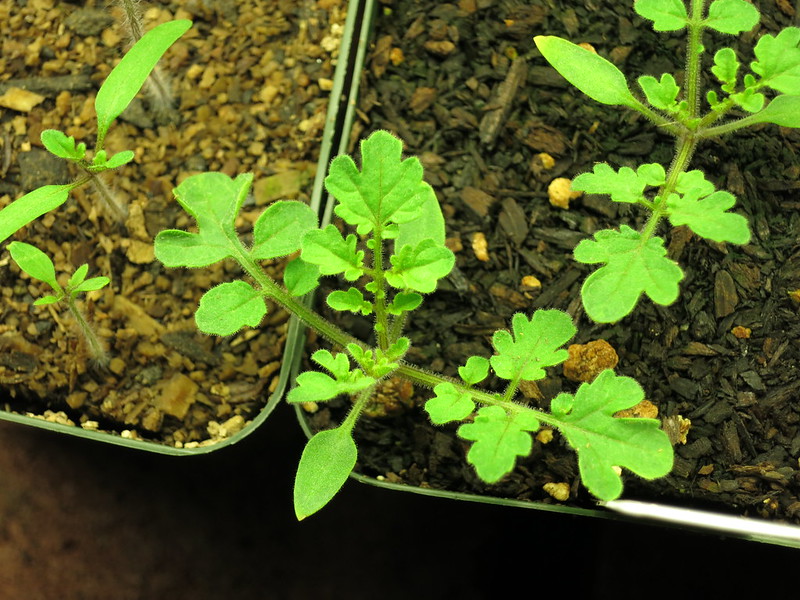 4) Here's the species that I'm currently most excited about, Solanum peruvianum LA0462. Very easy to grow so far. This is the variant that has leaves that smell like a mixture of orange, cinnamon, and some secondary plant compound-it's almost mouth watering! All individuals from this population smell similar. Some individuals have more purple in the leaves than others. If the leaves smell that good, I wonder how the fruits taste? The notes on this accession state the fruits are variable and are of good flavor, and I think there was a decent amount of genetic diversity in this seed batch. I sowed 7 seeds with no treatment, and 6/7 sprouted. After smelling the leaves and realizing this might be something special, I sowed another 5 seeds, no treatment, and 5/5 sprouted after 5 days! I think the recent hot days really helped speed up germination. This particular accession of Solanum chilense really wants as much direct sunlight as possible: the hypocotyls stretched like crazy, so I had to lower the light source. All other accessions under identical conditions didn't stretch, my lights are pretty strong: 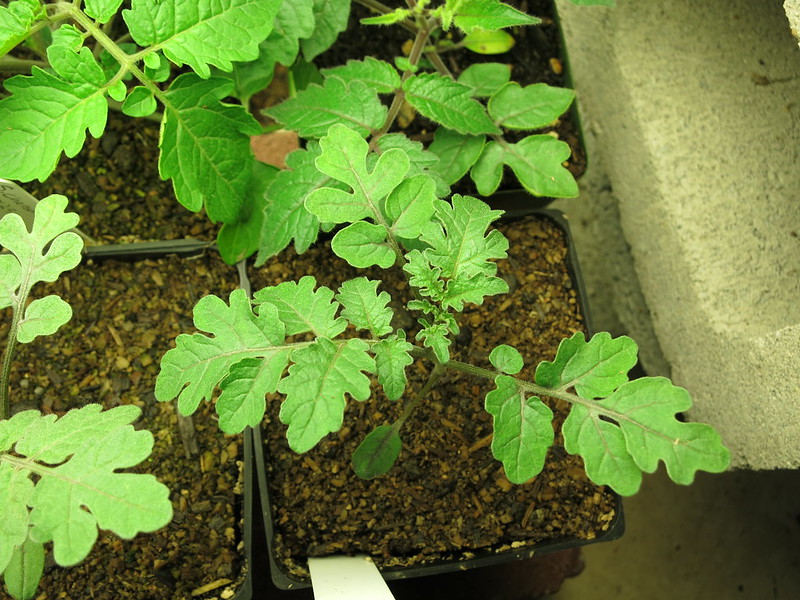 5) Solanum habrochaites LA2868 Germination was very easy with this seed batch, no treatment needed. Leaves are very hirsute, and they don't smell very strong. Of the little smell that I can sense, it's slightly unpleasant! Some purple colors on the leaves, likely due to cold stress? Very vigorous, but did take a while to recover from transplanting. Prefers well draining soil, slightly more picky than domesticated tomatoes: 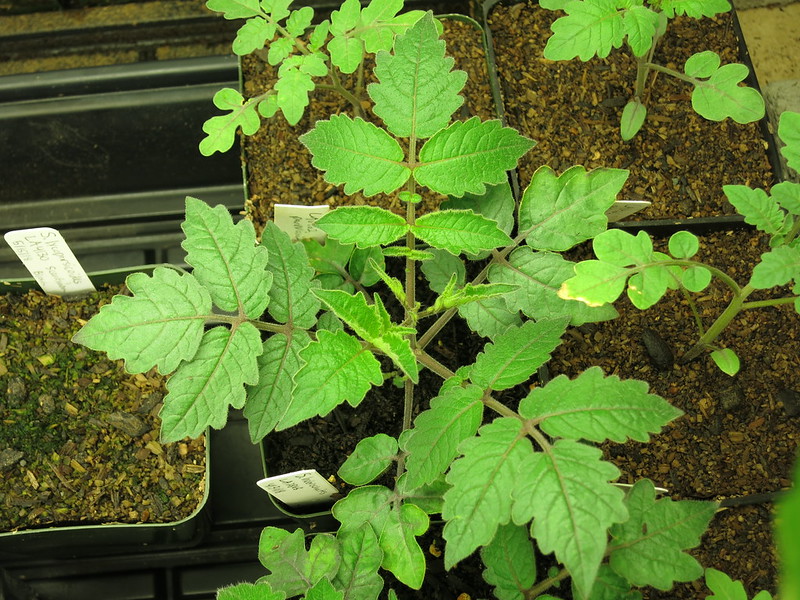 |
|


